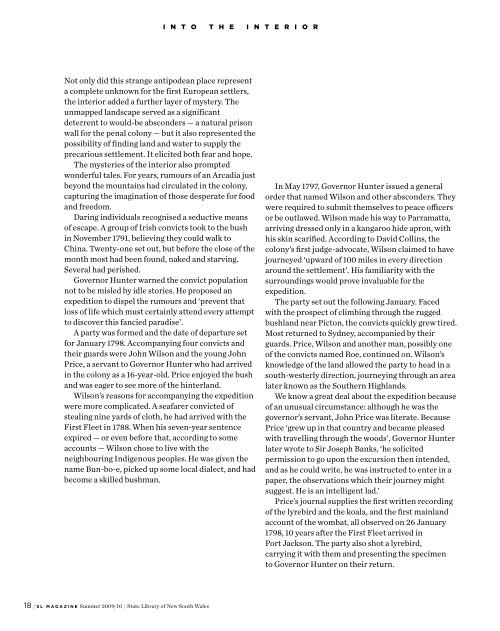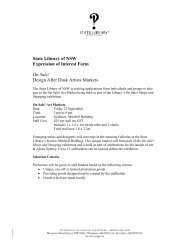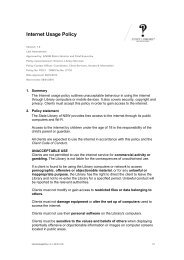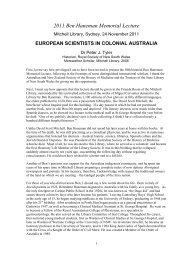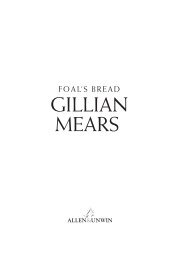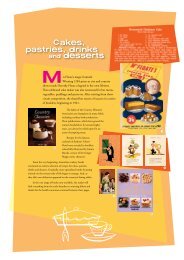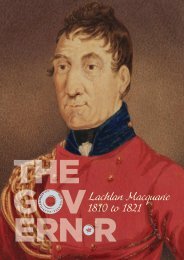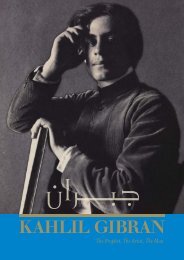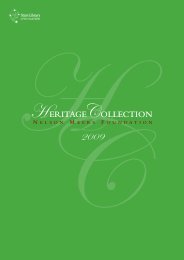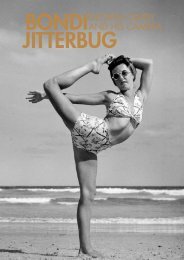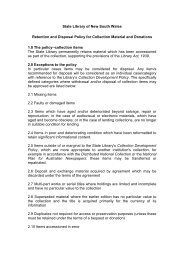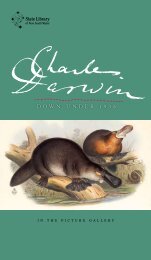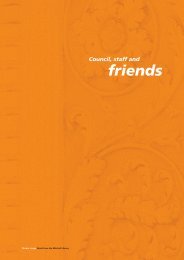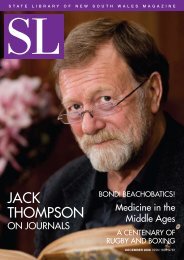Countdown to Mitchell centenary - State Library of New South Wales
Countdown to Mitchell centenary - State Library of New South Wales
Countdown to Mitchell centenary - State Library of New South Wales
You also want an ePaper? Increase the reach of your titles
YUMPU automatically turns print PDFs into web optimized ePapers that Google loves.
i n t o t h e i n t e r i o r<br />
Not only did this strange antipodean place represent<br />
a complete unknown for the first European settlers,<br />
the interior added a further layer <strong>of</strong> mystery. The<br />
unmapped landscape served as a significant<br />
deterrent <strong>to</strong> would-be absconders — a natural prison<br />
wall for the penal colony — but it also represented the<br />
possibility <strong>of</strong> finding land and water <strong>to</strong> supply the<br />
precarious settlement. It elicited both fear and hope.<br />
The mysteries <strong>of</strong> the interior also prompted<br />
wonderful tales. For years, rumours <strong>of</strong> an Arcadia just<br />
beyond the mountains had circulated in the colony,<br />
capturing the imagination <strong>of</strong> those desperate for food<br />
and freedom.<br />
Daring individuals recognised a seductive means<br />
<strong>of</strong> escape. A group <strong>of</strong> Irish convicts <strong>to</strong>ok <strong>to</strong> the bush<br />
in November 1791, believing they could walk <strong>to</strong><br />
China. Twenty-one set out, but before the close <strong>of</strong> the<br />
month most had been found, naked and starving.<br />
Several had perished.<br />
Governor Hunter warned the convict population<br />
not <strong>to</strong> be misled by idle s<strong>to</strong>ries. He proposed an<br />
expedition <strong>to</strong> dispel the rumours and ‘prevent that<br />
loss <strong>of</strong> life which must certainly attend every attempt<br />
<strong>to</strong> discover this fancied paradise’.<br />
A party was formed and the date <strong>of</strong> departure set<br />
for January 1798. Accompanying four convicts and<br />
their guards were John Wilson and the young John<br />
Price, a servant <strong>to</strong> Governor Hunter who had arrived<br />
in the colony as a 16-year-old. Price enjoyed the bush<br />
and was eager <strong>to</strong> see more <strong>of</strong> the hinterland.<br />
Wilson’s reasons for accompanying the expedition<br />
were more complicated. A seafarer convicted <strong>of</strong><br />
stealing nine yards <strong>of</strong> cloth, he had arrived with the<br />
First Fleet in 1788. When his seven-year sentence<br />
expired — or even before that, according <strong>to</strong> some<br />
accounts — Wilson chose <strong>to</strong> live with the<br />
neighbouring Indigenous peoples. He was given the<br />
name Bun-bo-e, picked up some local dialect, and had<br />
become a skilled bushman.<br />
In May 1797, Governor Hunter issued a general<br />
order that named Wilson and other absconders. They<br />
were required <strong>to</strong> submit themselves <strong>to</strong> peace <strong>of</strong>fcers<br />
or be outlawed. Wilson made his way <strong>to</strong> Parramatta,<br />
arriving dressed only in a kangaroo hide apron, with<br />
his skin scarified. According <strong>to</strong> David Collins, the<br />
colony’s first judge-advocate, Wilson claimed <strong>to</strong> have<br />
journeyed ‘upward <strong>of</strong> 100 miles in every direction<br />
around the settlement’. His familiarity with the<br />
surroundings would prove invaluable for the<br />
expedition.<br />
The party set out the following January. Faced<br />
with the prospect <strong>of</strong> climbing through the rugged<br />
bushland near Pic<strong>to</strong>n, the convicts quickly grew tired.<br />
Most returned <strong>to</strong> Sydney, accompanied by their<br />
guards. Price, Wilson and another man, possibly one<br />
<strong>of</strong> the convicts named Roe, continued on. Wilson’s<br />
knowledge <strong>of</strong> the land allowed the party <strong>to</strong> head in a<br />
south-westerly direction, journeying through an area<br />
later known as the <strong>South</strong>ern Highlands.<br />
We know a great deal about the expedition because<br />
<strong>of</strong> an unusual circumstance: although he was the<br />
governor’s servant, John Price was literate. Because<br />
Price ‘grew up in that country and became pleased<br />
with travelling through the woods’, Governor Hunter<br />
later wrote <strong>to</strong> Sir Joseph Banks, ‘he solicited<br />
permission <strong>to</strong> go upon the excursion then intended,<br />
and as he could write, he was instructed <strong>to</strong> enter in a<br />
paper, the observations which their journey might<br />
suggest. He is an intelligent lad.’<br />
Price’s journal supplies the first written recording<br />
<strong>of</strong> the lyrebird and the koala, and the first mainland<br />
account <strong>of</strong> the wombat, all observed on 26 January<br />
1798, 10 years after the First Fleet arrived in<br />
Port Jackson. The party also shot a lyrebird,<br />
carrying it with them and presenting the specimen<br />
<strong>to</strong> Governor Hunter on their return.<br />
18 / s l m a g a z i n e Summer 2009/10 / <strong>State</strong> <strong>Library</strong> <strong>of</strong> <strong>New</strong> <strong>South</strong> <strong>Wales</strong>


